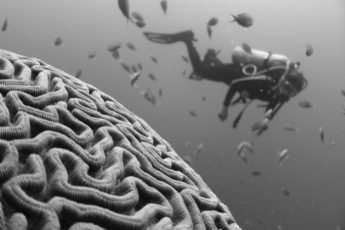Treating addictions can be tricky because addictions serve a purpose in the addicted person’s life, despite being self-destructive in the long run. Where to start first, the underlying trauma or the addiction, has always been a dilemma for trauma therapists. If one addresses the trauma first there is a possibility of triggering difficult emotions, such as fear, anger, and despair, which the addiction helped mask, albeit in an unhealthy manner. In fact, research shows that clients with addictions who receive only trauma therapy have a higher therapy dropout rate. (Roberts et al., 2015) On the other hand, if one addresses the addiction first, symptoms from the underlying trauma steadily continue to fuel the perceived need for the addiction. Thus, treating the addiction first leaves the client without resources to cope with the sometimes overwhelming symptoms of the trauma. It just becomes too difficult to cope. Therefore, therapy that is not trauma-focused is ineffective with clients who have concurrent trauma and addiction. (Roberts et al., 2015)
A solution would be to do a blend of trauma-focused EMDR therapy in conjunction with addiction-focused EMDR therapy. A full description of traditional EMDR trauma-focused therapy can be found in this author’s blog, What to Expect in EMDR Therapy, at emdrway.com. Briefly, trauma-focused EMDR therapy uses an eight-phase protocol that targets specific elements of the trauma memory to be processed using bilateral stimulation. The trauma memory becomes adaptive in that the client experiences a felt sense that the trauma is over, in the past.
A blend of trauma and addiction-focused EMDR protocols is depicted by Markus and Hornsveld (2017) who describe a “palette of EMDR interventions in addiction”. Markus & Hornsveld’s EMDR intervention suggestions are in the form of modules and are as follows:
Module 1: Safe Place Procedure and Resource Development Installation: Safe place is having the client visualize a place where they could feel safe, have them notice how their feel body feels when thinking about the safe place, and tapping it in using bilateral stimulation. This safe state is linked with a cue word that the client can use when needed to immediately reproduce the calm state.
There are countless other resources that can be developed using EMDR including enhancing positive self-imaging of ones traits; developing internal figures of a loving nurturer, a strong protector, and inner wisdom along with a circle of helpers; resetting affective circuits for emotion regulation; preparation for managing future stressful events; and grounding in the present moment to name a few.
Module 2: Installation of a Positive Treatment Goal: Many people come to treatment with the intention of avoiding future negative consequences that resulted from the addiction. Developing a positive treatment goal moves the client toward, instead of away from. This change in motivational dynamics predicts higher rates of abstinence.
Module 3: Trauma-focused EMDR for Comorbid Posttraumatic Stress Disorder: Posttraumatic Stress Disorder often stems from experiencing a trauma. If present, treating the PTSD takes precedence and is necessary early on in the treatment, even if the client is still abusing drugs or alcohol. Ideally, treating the PTSD with traditional trauma-focused EMDR can be integrated with addiction-focused EMDR, but should not be neglected until after addiction treatment.
Module 4: Trauma-focused EMDR for Emotional Problems in Patients With Addiction and Without Posttraumatic Stress Disorder: Many addicted people have experienced trauma but fall under the threshold of a PTSD diagnosis. They suffer from cumulative small “t” traumas, often from negative life experiences in childhood, leading to depression and anxiety. The addiction is a form of self-medicating. If the addiction is used to regulate emotions, then traditional trauma-focused EMDR should be used either first or in tandem with addiction-focused EMDR.
Module 5: Trauma-Focused EMDR for Patients With Debilitating Negative Core Beliefs: This EMDR intervention uses the two method approach described by de Jongh, Broecke, and Meijer (2010). For clients who developed a negative self-image from abuse or a toxic environment that was ongoing, therefore making it difficult to name a specific target to process, they suggest naming key incidents that contributed to the negative core belief, and prioritize them, not just as to how traumatizing, but also as to the source. Abuse by parents or major caretakers is most damaging, especially in early childhood when the child has not developed an internal sense of self sufficiently.
Module 6: Addiction-Focused EMDR on Negative Flash-Forwards of Prolonged Abstinence: Addicted people often fear to quit due to negative beliefs about extended abstinence. Anticipating nonstop cravings or the loss of social life built around the addiction creates obstacles that keep them from attempting abstinence. An EMDR flash forward can help put the perceived obstacles into a more realistic perspective by identifying the most disturbing expectation of abstinence and targeting it in sets of bilateral stimulation, resulting in enhanced expectations of overcoming rather than being overcome.
Module 7: Addiction-Focused EMDR on Negative Flash-Forwards of Relapse: Another negative belief that impedes abstinence is the fear of relapse. Here EMDR is used to reduce the catastrophic view of relapse, again gaining perspective.
Module 8: Addiction-Focused EMDR for Memories of Relapse: Using EMDR to process memories of relapse is two-fold, according to Hase (2010). He said that cravings are triggered by “addiction memories”, among other things. EMDR both creates more adaptive beliefs regarding the relapse memory and reduces cravings.
Module 9: Addiction-Focused EMDR for Memories of Craving: Using the traditional EMDR protocol, the client is asked to identify the first, worst and last memories of craving for reprocessing in order to desensitize them, thus reducing their power. Processing these memories is key for maintaining abstinence.
Module 10: EMDR on Positive Memories: Ideally, the most pleasant and recent memories of the positive experiences surrounding the addiction (i.e. pleasurable high, feeling calm, feeling excited, etc.) are targeted because they continue to reinforce the addiction. Typically, after a few sets of bilateral stimulation targeting these positive memories, the client begins to recall the negative aspects of the addiction, thus serving to provide a more complete and true picture of the addiction’s impact on the client’s life.
Module 11: EMDR on Feeling States and “Linked Memories”: This is from Miller’s (2010) Feeling-State theory. His premise is that every unhealthy behavior is “linked” with the experience of meeting a healthy, human need. One example might be achieving a sense of belonging when at a bar drinking with friends. When this need is met one experiences a positive “feeling state” which is thereafter linked to the addiction. EMDR is used to break this link by adaptively opening the client’s awareness of the negative impact of the addiction.
Module 12: EMDR on Positive Flash-Forwards of the Behavior (Dry Use): This module targets the client’s visualization of performing the addictive behavior, a practice typically known to increase cravings. EMDR processing decreases the cravings associated with the performance memory and increases the development of positive alternative behavior.
Module 13: Addiction-Focused EMDR on Positive Flash Forwards About the Desired Goal: This module targets the visualization of the client’s desired purpose of the addiction instead of the actual performance. EMDR processing reveals the client’s goal as an idealization, a likely unreachable fantasy, thus desensitizing it as a compulsion to the addictive behavior.
Module 14: Addiction-Focused EMDR on Triggers: Using this module the client identifies triggers to craving from least powerful to most powerful. The triggers are then systematically processed to desensitization using EMDR.
Module 15: Future Templates, Imaginal Rehearsal, and Behavior Experiments: This module describes the third prong of EMDR therapy, i.e. the future. The client is asked to visualize an adaptive response to an anticipated triggering situation while undergoing bilateral stimulation. If difficulties occur, the bilateral stimulation stops and the client can develop a resolution to the obstacle with the therapist’s assistance. The visualization/bilateral stimulation continue until completion, only stopping to address negative blocks.
This “palette of interventions” gathered by Markus & Hornsveld (2017) was not designed as a specific protocol but instead meant to be used as a compilation from which the therapist can select depending upon the client’s needs. Also, these EMDR interventions are best applied following Prochaska & DiClemente’s Stages of Change (1982, 1992) of Pre-contemplation (of taking action), Contemplation (of taking action), Preparation (for taking action), Action (doing something to stop the addiction), and Maintenance (maintaining abstinence).
De Jongh, A., ten Broeke, E. & Meijer, S., (2010). Two Method Approach: A Case Conceptualization Model in the Context of EMDR. Journal of EMDR Practice and Research, (4)1, 12-21
Hase, M. (2010). CraveEx: An EMDR approach to treat substance abuse and addiction. In Luber (Ed.), Eye movement desensitization and reprocessing (EMDR) scripted protocols: Special populations (pp. 467-488). New York, NY: Springer Publishing
Markus, W., & Hornsveld, H.K. (2017) EMDR Interventions in Addiction. Journal of EMDR Practice and Research, (11)1, 3-29
Miller, R. (2010). The feeling-state theory of impulse control disorder and the impulse-control disorder protocol. Traumatology, 16(3), 2-10.
Reiter, L.J. (2018) What to Expect in EMDR Therapy. EMDRway.com.
Roberts, N.P., Roberts, P.A., Jones, N., & Bisson, J.I. (2015) Psychological interventions for post-traumatic stress disorder and comorbid substance use disorder: A systematic review and meta-analysis. Clinical Psychology Review, 38, 25-38.
Prochaska, J.O., & DiClemente, C.C. (1982). Transtheoretical therapy: Toward a more integrative model of change. Psychotherapy: Theory, Research, and Practice, 19(3), 276-288.
Prochaska, J.O., & DiClemente, C.C. (1992) Stages of change in the modification of problem behaviors. In M. Hersen, R.M. Eisler, & P.M. S Miller (Eds.), Progress in behavior modification (Vol. 28, pp. 183-218). Sycamore, IL: Sycamore





